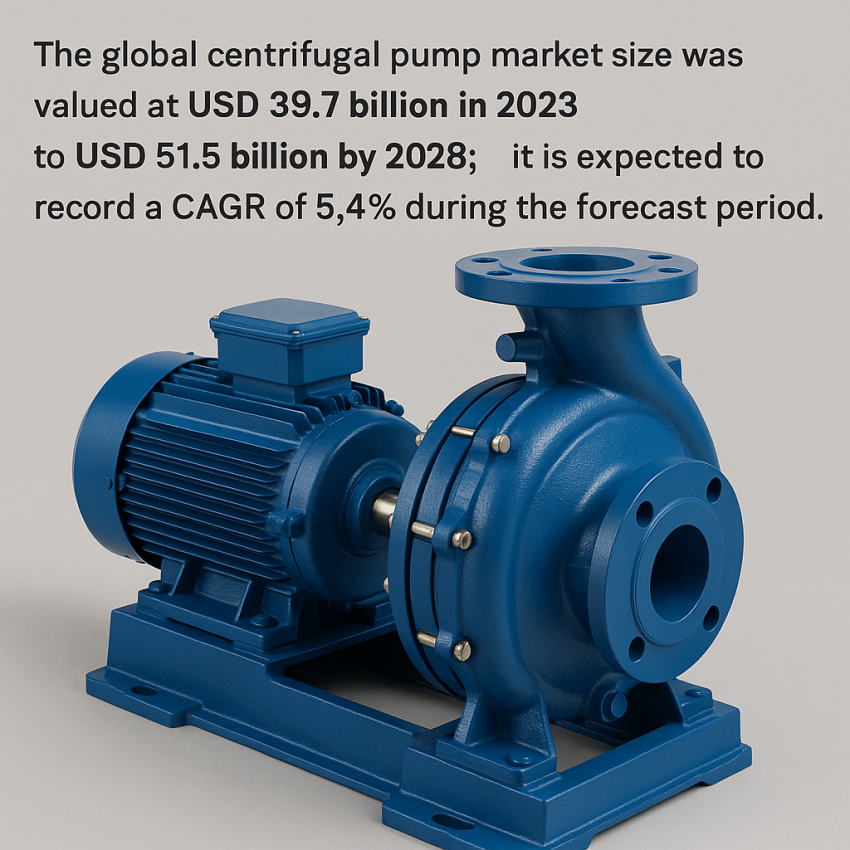The global centrifugal pump industry is poised for significant growth, driven by expanding industrial activities, agricultural demands, and infrastructure development worldwide. Valued at approximately USD 39.7 billion in 2023, the market is projected to reach USD 51.5 billion by 2028, growing at a compound annual growth rate (CAGR) of 5.4% during this period.
Market Overview and Key Drivers
Centrifugal pumps are essential in various sectors such as wastewater treatment, chemicals, petrochemicals, and agriculture. Their primary function in wastewater treatment includes sewage transfer, sludge handling, and effluent treatment, which is increasingly important due to rising environmental regulations and a global focus on sustainability. The growing need for efficient water management and treatment is a major driver for centrifugal pump demand.
Agriculture is another critical sector fueling market growth. Many emerging economies rely heavily on conventional irrigation techniques, where centrifugal pumps are widely used. The adoption of solar-powered centrifugal pumps in agriculture is gaining momentum, supported by government subsidies aimed at improving irrigation efficiency and boosting crop productivity. Regions like Sub-Saharan Africa and South Asia, experiencing rapid population growth and agricultural expansion, are expected to be key markets for these pumps. Africa, in particular, shows significant potential to not only meet its own food needs but also contribute to global food supply, further driving centrifugal pump demand.
Download PDF Brochure – https://www.marketsandmarkets.com/pdfdownloadNew.asp?id=17494785
Market Challenges and Opportunities
Despite the promising outlook, the market faces challenges such as cavitation and dry-run failures. Cavitation occurs when vapor bubbles form and collapse inside the pump, causing damage to the impeller and reducing pump efficiency. These issues increase maintenance costs and can limit market growth. Additionally, competition from unorganized sectors, including local and gray market players offering cheaper and often lower-quality products, poses a significant challenge to established manufacturers.
On the opportunity front, the increased adoption of solar water pumps presents a sustainable solution, especially in regions lacking reliable grid electricity. Solar-powered centrifugal pumps convert solar energy into electrical energy to operate the pumps, providing a reliable irrigation system that reduces dependency on fuel-based power. This is particularly beneficial in Africa and other developing regions, where access to safe drinking water and efficient irrigation is critical. The United Nations reports that about 2.2 billion people lack access to safe drinking water, and with rising water consumption and wastewater discharge, the demand for efficient pumping solutions is expected to grow.
Market Segmentation
By Type
The market is segmented into overhung impeller, between bearing, and vertically suspended centrifugal pumps. Overhung impeller pumps are the largest segment due to their compact design and versatility, especially in residential and commercial water supply systems.
By Operation Type
Electrical pumps dominate the market, with growing adoption of solar-powered variants. Hydraulic and air-driven pumps also serve specific industrial applications where leak-free and damage-free operations are critical.
By Stage
Single-stage centrifugal pumps are the fastest-growing segment, favored for their reliability and lower maintenance costs. They are widely used in North America, driven by modernization efforts in water supply and wastewater treatment plants, as well as developments in the oil and gas sector. Multistage pumps, while offering higher pressure capabilities, involve higher maintenance costs.
By End User
The industrial sector is the largest consumer of centrifugal pumps, with significant demand from oil and gas, chemicals, mining, food and beverages, and pharmaceuticals. The pharmaceutical industry, in particular, is a fast-growing segment due to the need for handling corrosive materials and solvents, alongside increasing healthcare demands and vaccine production. Commercial and residential sectors also contribute to market growth through new construction and infrastructure projects.
By Region
Asia Pacific is the fastest-growing region for centrifugal pumps, driven by rapid industrialization, infrastructure investments, and agricultural expansion. The region’s growing population and the need to enhance agricultural productivity amid climate challenges are key factors. North America and Europe also maintain strong markets due to ongoing modernization and technological advancements.
Competitive Landscape
The centrifugal pump industry is dominated by global players such as Xylem Inc. (US), Sulzer (Switzerland), KSB (Germany), Grundfos Holding A/S (Denmark), and Flowserve Corporation (US). These companies invest heavily in R&D, maintain diversified product portfolios, and leverage strong global sales and marketing networks. Recent strategic moves include acquisitions and partnerships to enhance water treatment solutions and expand market reach—for example, Grundfos’s acquisition of Water Works Inc. and Xylem’s agreement to acquire Evoqua, a leader in water treatment services.
Ask Sample Pages of the Report – https://www.marketsandmarkets.com/requestsampleNew.asp?id=17494785
Future Outlook
The centrifugal pump market is expected to continue its steady growth, supported by technological advancements such as IoT-driven pumps, digital twin technology, and machine learning integration. These innovations improve efficiency, reliability, and predictive maintenance capabilities. Furthermore, the increasing focus on renewable energy sources, especially solar-powered pumps, aligns with global sustainability goals and addresses water scarcity challenges.
In summary, the centrifugal pump market is on a robust growth trajectory fueled by industrial demand, agricultural expansion, and environmental regulations. While challenges like cavitation and unorganized competition exist, opportunities in solar-powered pumps and emerging markets, particularly in Asia Pacific and Africa, present significant potential for manufacturers and stakeholders in the coming years.

